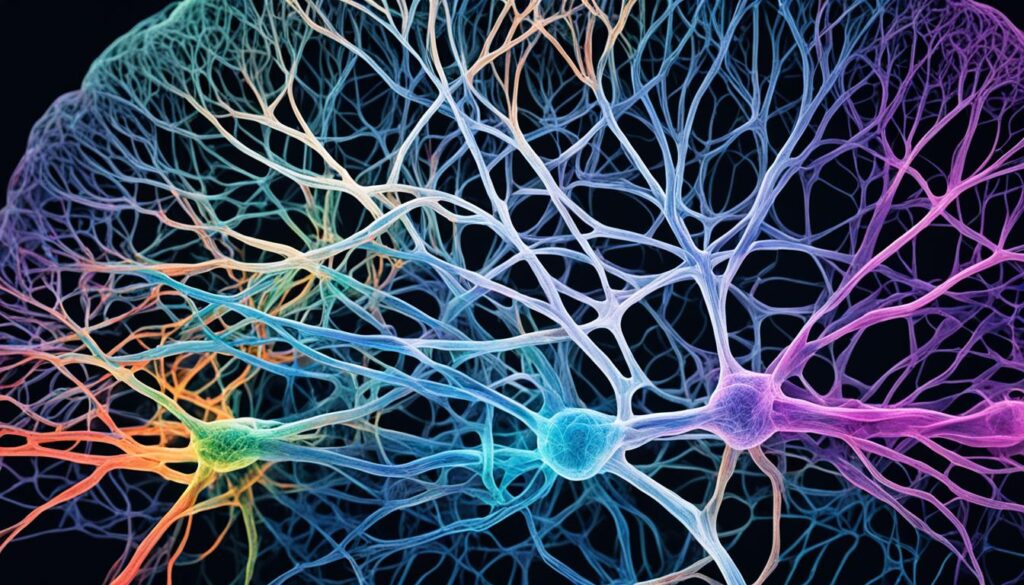Were you aware that approximately 1.6% of adults in the United States are impacted by borderline personality disorder (BPD)? This significant statistic emphasizes the intricacy of this mental health issue and underscores the importance of gaining a more profound comprehension of its origins and risk factors.
BPD is not a condition with a simple origin. It is influenced by a combination of genetic, environmental, and psychological factors. Genetic factors play a role, as there is evidence that BPD can run in families. Additionally, abnormalities in brain chemicals and structures have been observed in individuals with BPD. Environmental factors, such as childhood trauma and unstable relationships, can also contribute to the development of BPD.
In this article, we will delve into the various causes of BPD, exploring genetic, environmental, neurobiological, psychological, and developmental factors. By gaining a comprehensive understanding of these underlying causes, we can better identify and treat BPD, providing hope and support to those affected.
Key Takeaways:
- BPD is a complex condition influenced by genetic, environmental, and psychological factors.
- Genetic factors play a role in predisposing individuals to BPD.
- Abnormalities in brain structure and chemicals may contribute to BPD symptoms.
- Environmental factors, such as childhood trauma, can increase the risk of developing BPD.
- Understanding the causes of BPD is crucial for accurate diagnosis and effective treatment.
Genetic Factors in BPD
When it comes to understanding the causes of borderline personality disorder (BPD), genetic factors have shown to play a significant role. Research has revealed that individuals with a family history of BPD or other mental health disorders are at an increased risk of developing the condition themselves. While specific genes associated with BPD have not been identified, it is believed that a combination of genetic variations contributes to the vulnerability of developing the disorder.
Essentially, genetic factors create a predisposition to BPD, making certain individuals more susceptible to developing the disorder. These genetic variations may influence the way the brain processes and regulates emotions, contributing to the characteristic symptoms of BPD.
The Role of Family History
Family history plays a crucial role in understanding the genetic causes of BPD. Studies have observed that individuals with parents or siblings diagnosed with BPD are more likely to develop the disorder themselves. This indicates that there may be a hereditary component to BPD, where certain genetic traits increase the risk of developing the condition.
Genetic factors create a predisposition to BPD, making certain individuals more susceptible to developing the disorder.
Complex Genetic Interactions
While the exact genes responsible for BPD have not been pinpointed, it is believed that multiple genetic variations interact with each other to contribute to the development of the disorder. These genetic interactions may affect the functioning of neurotransmitters, such as serotonin, which play a crucial role in regulating emotions and mood.
A better understanding of the genetic causes of BPD holds promise for improved diagnosis, treatment, and prevention strategies. By identifying specific genetic markers associated with the disorder, researchers can develop targeted interventions that address the underlying biological mechanisms.
| Genetic Factors in BPD | Risk Factors |
|---|---|
| Family history of BPD | Increased likelihood of developing the disorder |
| Genetic variations | Predisposition to BPD |
| Complex interactions | Affecting neurotransmitter functioning |
Environmental Factors in BPD
Environmental influences play a significant role in the development of borderline personality disorder (BPD). Particularly, childhood experiences can shape an individual’s vulnerability to the condition. Various risk factors are associated with BPD, including:
- Emotional, physical, or sexual abuse during childhood
- Long-term fear or distress experienced during childhood
- Neglect or deprivation of emotional needs
- Growing up in a household with a family member with a serious mental health condition or substance abuse problem
- Unstable or invalidating relationships
These environmental factors can contribute to the development of BPD by impacting a person’s emotional and psychological well-being. Childhood trauma, such as abuse or neglect, can shape an individual’s attachment style and ability to regulate emotions. Additionally, growing up in an unstable or invalidating environment can create a foundation for difficulties in interpersonal relationships and emotional stability.

“Our upbringing and the environment we grow up in can have a profound impact on our mental well-being. For individuals with BPD, adverse childhood experiences and unstable relationships can significantly contribute to the development of the disorder.”
Understanding and addressing the environmental factors that contribute to BPD is crucial for effective diagnosis and treatment. A comprehensive approach that encompasses psychotherapy, such as Dialectical Behavior Therapy (DBT), can help individuals with BPD develop healthier coping mechanisms and improve their emotional regulation skills.
Neurobiological Factors in BPD
Neurobiological factors play a significant role in understanding borderline personality disorder (BPD). Research has shown that individuals with BPD exhibit abnormalities in brain structure and function, which contribute to the emotional dysregulation and impulsivity commonly seen in this condition.

MRI scans have provided valuable insights into the neurobiology of BPD. These scans have revealed that specific brain regions, such as the amygdala, hippocampus, and orbitofrontal cortex, may be smaller or exhibit abnormal activity in individuals with BPD. These findings suggest that structural and functional differences in these brain areas contribute to the symptoms and behaviors associated with BPD.
The amygdala, known for its role in processing emotions, has been found to be hyperactive in individuals with BPD. This hyperactivity may contribute to the intense emotional reactions and emotional dysregulation experienced by individuals with the disorder.
The hippocampus, which plays a crucial role in memory and emotions, has also been implicated in BPD. Research suggests that individuals with BPD have smaller hippocampal volumes, potentially affecting their ability to regulate emotions and memories.
Further, the orbitofrontal cortex, responsible for decision-making and impulse control, seems to show abnormalities in individuals with BPD. These abnormalities may contribute to the impulsive and self-destructive behaviors often observed in this population.
Overall, the neurobiological factors in BPD provide valuable insights into the origins and mechanisms of the disorder. The abnormalities observed in brain structure and function highlight the complex interplay between biology and behavior in individuals with BPD.
Neurobiological Factors in BPD: Key Findings
| Brain Region | Abnormalities Observed |
|---|---|
| Amygdala | Hyperactivity, contributing to emotional dysregulation |
| Hippocampus | Smaller volumes, affecting emotion regulation and memory |
| Orbitofrontal Cortex | Abnormalities in decision-making and impulse control |
Psychological Factors in BPD
When it comes to understanding the causes of borderline personality disorder (BPD), psychological factors play a significant role. An individual’s early upbringing and attachment style can greatly contribute to the development of BPD.
Difficulties in emotion regulation and coping skills can increase the risk of developing BPD. These individuals may struggle to effectively manage and cope with intense emotions, leading to emotional dysregulation and instability.
Furthermore, individuals with BPD often have a negative self-image. They may struggle with low self-esteem, feelings of worthlessness, and a sense of being fundamentally flawed. These negative self-perceptions can fuel the emotional turbulence experienced in BPD.
Moreover, individuals with BPD may exhibit a heightened sensitivity to perceived rejection or abandonment. This sensitivity can trigger intense fear and anxiety, making it challenging for them to establish and maintain stable relationships.
“An individual’s early upbringing and attachment style can greatly contribute to the development of BPD.”
Understanding these psychological factors is crucial for effectively addressing and treating BPD. With the right therapeutic interventions and support, individuals with BPD can develop healthier coping mechanisms, improve their self-image, and enhance their interpersonal relationships.

| Psychological Factors | Risk Factors for BPD |
|---|---|
| Difficulties in emotion regulation and coping skills | Increases the risk of developing BPD |
| Negative self-image | Contributes to emotional dysregulation in BPD |
| Heightened sensitivity to perceived rejection or abandonment | Creates challenges in establishing and maintaining stable relationships |
Developmental Factors in BPD
When it comes to the development of borderline personality disorder (BPD), it’s important to consider the role that developmental factors play. Early attachment disruptions and difficulties in emotional and social development can have a significant impact on the development of BPD.
Individuals who have experienced trauma, neglect, or inconsistent caregiving during their formative years may have a distorted perception of themselves and others. These early developmental experiences shape their ability to regulate emotions, form and maintain healthy interpersonal relationships, and establish a stable self-identity.
Children who have experienced trauma, such as physical or emotional abuse, are at a higher risk of developing BPD later in life. Additionally, growing up in an environment where a family member has a serious mental health condition or substance abuse problem can also contribute to the development of BPD.
These developmental factors can have a lasting impact on individuals, influencing their emotional well-being and interpersonal interactions. Understanding and addressing these factors are crucial in providing effective support and treatment for individuals with BPD.
The Impact of Developmental Factors in BPD
Developmental factors can impact various aspects of an individual’s life, contributing to the symptoms of BPD. Here are some key areas affected by developmental factors:
- Emotion Regulation: Individuals with a history of developmental disruptions may struggle with regulating their emotions effectively. They may experience intense mood swings and have difficulty managing stress and frustration.
- Interpersonal Relationships: Difficulties in forming and maintaining stable relationships are common among individuals with BPD. Trust issues, fear of abandonment, and challenges in communication and conflict resolution often arise due to developmental factors.
- Self-Identity: Individuals with BPD may have an unstable sense of self, frequently shifting their self-perception based on external validation or criticism. A negative self-image and feelings of emptiness are common.
By examining and addressing these developmental factors, mental health professionals can provide targeted interventions to help individuals with BPD overcome these challenges and lead more fulfilling lives.
“Our early experiences shape the way we see ourselves and others. Addressing developmental factors in BPD treatment allows us to provide comprehensive support and help individuals heal from past wounds.” – Dr. Jane Thompson, Clinical Psychologist

| Developmental Factors | Impact on BPD |
|---|---|
| Early attachment disruptions | Distorted self-perception and difficulties in forming trusting relationships |
| Emotional and social development challenges | Difficulties in regulating emotions and managing interpersonal interactions |
| History of trauma and neglect | Increased risk of developing BPD and heightened emotional dysregulation |
| Family environment with mental health issues | Higher likelihood of developing BPD and challenges in maintaining stable relationships |
Understanding the developmental factors involved in BPD empowers us to provide more targeted support and interventions. By addressing these factors in therapeutic settings, individuals with BPD can work towards healing, growth, and improved well-being.
Understanding Borderline Personality Disorder
Borderline personality disorder (BPD) is a mental illness characterized by difficulties in regulating emotions and unstable relationships. It affects millions of individuals worldwide, and understanding its symptoms and signs is crucial for recognizing and seeking appropriate help.
What is Borderline Personality Disorder?
Borderline personality disorder is a complex condition that affects a person’s thoughts, emotions, and behaviors, making it challenging to maintain stable relationships and navigate daily life. People with BPD often experience intense mood swings, with emotional highs and lows that can change rapidly. They may struggle with a distorted self-image, constantly feeling unsure of who they are or what they want in life.
This mental health condition is deeply distressing and can lead individuals to engage in impulsive behaviors, such as reckless spending, substance abuse, or engaging in self-harm. Additionally, people with BPD may have difficulties managing anger and expressing their emotions in healthy ways. They may also experience a persistent fear of abandonment, leading to intense and often unstable relationships.
Symptoms and Signs of BPD
While the symptoms of borderline personality disorder can vary from person to person, several common signs indicate its presence. These include:
- Intense and rapidly fluctuating emotions
- Feelings of emptiness and intense loneliness
- Impulsive and risky behaviors, such as self-harm, substance abuse, or reckless driving
- Unstable self-image and sense of self
- Frequent and intense mood swings
- Chronic feelings of worthlessness or inadequacy
- Difficulty maintaining stable relationships
- Intense fear of abandonment
It is essential to remember that these symptoms can vary in severity and may overlap with other mental health conditions. A professional diagnosis is necessary for proper identification and treatment.
Seeking Help and Treatment
If you or someone you know is experiencing the symptoms mentioned, it is crucial to seek professional help. A mental health professional, such as a psychiatrist or psychologist, can conduct a comprehensive assessment and make an accurate diagnosis.
Treatment for borderline personality disorder often involves a combination of psychotherapy and, in some cases, medication. Psychotherapy, especially Dialectical Behavior Therapy (DBT), can help individuals learn coping mechanisms, regulate emotions, and improve relationships. Medications may be prescribed to manage specific symptoms or any co-occurring mental health conditions.

With early intervention and appropriate treatment, individuals with borderline personality disorder can lead fulfilling lives and experience significant improvements in their overall well-being.
Diagnosis and Treatment of BPD
Diagnosing borderline personality disorder (BPD) requires the expertise of a licensed mental health professional who conducts a comprehensive assessment of symptoms and an in-depth interview. This thorough evaluation helps to accurately identify BPD and rule out other conditions with similar symptoms. It is important for individuals with concerns about BPD to seek professional help for an accurate diagnosis.
The primary approach to treating BPD is psychotherapy, which can provide individuals with the necessary tools and skills to manage their symptoms effectively. Two commonly used therapies for BPD are Dialectical Behavior Therapy (DBT) and Cognitive Behavioral Therapy (CBT).
1. Dialectical Behavior Therapy (DBT)
DBT is a specialized form of therapy that focuses on assisting individuals with BPD in developing strategies to regulate their emotions, manage impulsive behaviors, and improve communication and relationships. Through a combination of individual therapy, group skills training, phone coaching, and therapist consultation, DBT fosters a supportive environment for individuals to learn and practice healthy coping mechanisms.
2. Cognitive Behavioral Therapy (CBT)
Cognitive Behavioral Therapy (CBT) is another evidence-based therapy that is effective in treating BPD. CBT helps individuals identify and change negative thought patterns and behaviors, enabling them to develop healthier perspectives and improve emotional regulation. By challenging negative beliefs and promoting adaptive coping strategies, CBT can help individuals enhance their overall well-being.
In addition to psychotherapy, medications may be prescribed to manage specific symptoms associated with BPD or any co-occurring mental health conditions that individuals may experience. Antidepressants, mood stabilizers, and antipsychotic medications can be used in conjunction with therapy to help individuals achieve symptom relief.

It is crucial for individuals with BPD to seek treatment from properly trained professionals specializing in the diagnosis and management of the disorder. Ongoing support and regular therapy sessions are essential for individuals with BPD to effectively manage their symptoms and work towards a healthier life.
| Treatment Approaches | Description |
|---|---|
| Dialectical Behavior Therapy (DBT) | Specialized therapy that helps individuals with BPD regulate emotions, manage impulsive behaviors, and improve relationships. |
| Cognitive Behavioral Therapy (CBT) | Therapy that focuses on identifying and changing negative thought patterns and behaviors, promoting healthier perspectives and emotional regulation. |
| Medications | Prescribed to manage specific symptoms or co-occurring mental health conditions, such as antidepressants, mood stabilizers, and antipsychotic medications. |
Conclusion
Borderline personality disorder (BPD) is a complex condition influenced by various causes, including genetic, environmental, and psychological factors. Genetic predisposition plays a role in BPD, with evidence suggesting that the condition can run in families. Abnormalities in brain structure and chemicals, such as serotonin, can contribute to the symptoms of BPD. Environmental factors, like childhood trauma and unstable relationships, also increase the risk of developing BPD.
Understanding the causes of BPD is crucial for effective diagnosis and treatment. Psychotherapy, particularly Dialectical Behavior Therapy (DBT) and Cognitive Behavioral Therapy (CBT), is the primary approach for managing BPD. These therapies help individuals develop healthier coping strategies and improve their emotional regulation. In some cases, medications may be prescribed to manage specific symptoms or co-occurring mental health conditions.
With appropriate treatment and support, individuals with BPD can lead fulfilling lives. It is important for those affected by BPD to seek help from trained professionals and engage in ongoing therapy. By addressing the underlying causes and learning effective strategies for managing symptoms, individuals with BPD can experience improved well-being and develop healthier relationships.
FAQ
What are the causes of borderline personality disorder?
Borderline personality disorder (BPD) is believed to be influenced by a combination of genetic, environmental, and psychological factors. Genetic factors, such as a family history of BPD or other mental health disorders, can increase the risk of developing BPD. Environmental factors, including childhood trauma and growing up in a household with a family member with mental health issues, also contribute to the development of BPD. Psychological factors, such as difficulties in emotion regulation and negative self-image, can also play a role in the development of BPD.
Are there genetic factors involved in BPD?
Yes, research suggests that genetics play a role in the development of BPD. Individuals with a family history of BPD or other mental health disorders may have a higher risk of developing the condition themselves. Specific genes have not been identified, but it is believed that a combination of genetic variations contributes to the vulnerability to developing BPD.
What are some environmental factors that contribute to BPD?
Environmental factors, particularly childhood experiences, can contribute to the development of BPD. Individuals who have experienced emotional, physical, or sexual abuse, as well as long-term fear or distress during childhood, are more likely to develop BPD. Growing up in a household with a family member with a serious mental health condition or substance abuse problem, neglect, and unstable or invalidating relationships can also increase the risk of developing BPD.
Are there neurobiological factors involved in BPD?
Yes, neurobiological factors have been observed in individuals with BPD. MRI scans have shown that certain parts of the brain, such as the amygdala, hippocampus, and orbitofrontal cortex, may be smaller or have abnormal activity in individuals with BPD. These brain abnormalities may contribute to the emotional dysregulation and impulsivity seen in individuals with BPD.
What psychological factors contribute to the development of BPD?
Psychological factors, including an individual’s early upbringing and attachment style, can contribute to the development of BPD. Difficulties in emotion regulation and coping skills, as well as a negative self-image, may increase the risk of developing BPD. Additionally, individuals with BPD may have a heightened sensitivity to perceived rejection or abandonment, leading to intense fear and difficulty in maintaining stable relationships.
How do developmental factors contribute to BPD?
Developmental factors, such as disruptions in early attachment and difficulties in emotional and social development, may contribute to the development of BPD. Early experiences of trauma, neglect, or inconsistent caregiving can shape the way individuals with BPD perceive themselves and others. These developmental factors can impact emotion regulation, interpersonal relationships, and self-identity, contributing to the symptoms of BPD.
What is borderline personality disorder?
Borderline personality disorder is a mental illness characterized by difficulties in regulating emotions and unstable relationships. Individuals with BPD may experience intense mood swings, have a distorted self-image, exhibit impulsive behavior, engage in self-harm or suicidal behaviors, and struggle with intense and unstable relationships. Symptoms of BPD can vary in severity and may be influenced by genetic, environmental, and psychological factors.
How is BPD diagnosed and treated?
BPD is typically diagnosed by a licensed mental health professional through a thorough interview and assessment of symptoms. Psychotherapy, particularly Dialectical Behavior Therapy (DBT) and Cognitive Behavioral Therapy (CBT), is the primary treatment approach for BPD. Medications may be prescribed to manage specific symptoms or co-occurring mental health conditions. It is important for individuals with BPD to seek treatment from appropriately trained professionals and to receive ongoing support.
Paul is a storyteller at heart, sharing narratives illuminating the lived experiences of those with BPD. His work encompasses a range of topics, from personal journeys to the challenges and triumphs faced by individuals navigating life with BPD. Paul’s authentic and engaging writing style invites readers into the world of BPD, promoting awareness and empathy.










